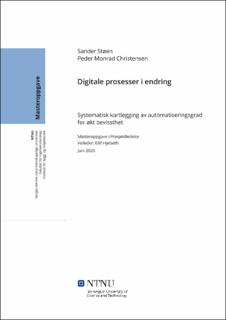| dc.contributor.advisor | Hjelseth, Eilif | |
| dc.contributor.author | Støen, Sander | |
| dc.contributor.author | Christensen, Peder Monrad | |
| dc.date.accessioned | 2021-09-20T16:16:03Z | |
| dc.date.available | 2021-09-20T16:16:03Z | |
| dc.date.issued | 2020 | |
| dc.identifier | no.ntnu:inspera:50403903:34440181 | |
| dc.identifier.uri | https://hdl.handle.net/11250/2779432 | |
| dc.description.abstract | Metodene i denne studien bidrar til å øke bevisstheten rundt behovet for å kartlegge konkrete muligheter for automatiserte prosesser hos rådgivende ingeniører, arkitekter og entreprenører. Den stadige økende kompleksiteten i prosjekter og den økende trenden av tilgjengelige verktøy, samt behovet for bedre og mer effektive prosesser gjør at nettopp man både kan og bør automatisere arbeidsoppgaver der dette er aktuelt. Observasjoner av manuelle og repeterende prosesser har vært en driver som har satt forfatterne på sporet av hvordan man øker automatiseringsgrad for næringen. I tillegg, er det undersøkt om det er andre faktorer enn repetisjon og hvor manuell en prosess er som styrer prosessens automatiseringsrelevans.
Studien er gjennomført med en kombinasjon av litteraturstudie, aksjonsforskning og semistrukturerte intervjuer. Litteraturstudien avdekket av det var gjort lite systematisk innen automatisering av ingeniørfaglige arbeidsoppgaver. Aksjonsforskingen ble gjennomført over fem uker som medarbeidere i et større konsulentselskap. Dette bidro til god innsikt i ingeniørfaglige samarbeidsprosesser og arbeidsmetoder. Selv om det var stor interesse for digitalisering, så var det lav bevissthet for automatisering av arbeidsoppgaver.
For å identifisere konkrete muligheter ble ti av de antatt mest kompetente innen digitalisering og automatisering intervjuet. Her fant forfatterne ytterligere aktiviteter modne for endring. Videre, oppdaget forfatterne flere muligheter og forutsetninger for å ta i bruk visuell programmering i prosjekteringsprosessen.
I løpet av studien, ble det klart at automatisering ikke bare krever investering i teknologi, men at det også påvirker dagens forretningsmodell. Prosesser blir mer effektive, omprosjektering tar kortere tid ved hjelp av verktøy som visuell programmering, og de rådgivende må dermed finne en alternativ metode til å skrive timer.
Studien foreslår konkrete forbedringer av 16 aktiviteter basert på analyse fra aksjonsforskningen og intervjuene med innovatørene. Det er kartlagt automatiseringsgrad for dagens situasjon og mulig fremtidig gjennomføring, og egnethet for automatisering. Erfaringer med metoden for identifisering av automatiseringsgrad anbefales å bli benyttet hos rådgivende ingeniører og andre som vil automatisere digitale arbeidsoppgaver.
For å øke automatiseringsgraden i bransjen må bevisstheten økes og barrierer overvinnes. Barrierer som endringsmotstand og lav teknologisk kompetanse begrenser digital transformasjon. Bedrifter oppfordres til å utrede og vurdere kompetansen og strukturen i eget firma, samt vurdere hvilken posisjon de ønsker å ha i fremtidens byggenæring. Sett i dette perspektivet vil økt automatiseringsgrad være en sentral bidragsyter for å øke konkurransefortrinnet. | |
| dc.description.abstract | The methods in this thesis contributes to increase the awareness of the need to map the opportunities in automating processes for the engineers, architects and contractors. The ever-increasing complexity in projects, the increase in available tools, as well as the need for better and more efficient processes implies that you can and should automate work tasks where applicable. Observations of manual and repetitive processes has been a driver that pointed the authors in the direction of how to increase the degree of automation for the industry. Additionally, it is investigated if there are other factors than repetition and how manual a process is that controls the process’ relevance regarding automation.
The study is performed by a combination of literature review, action research, and semi-structured interviews. The literature review revealed that there was little systematic research regarding the automation of engineering tasks. The action research was done over five weeks, as employees in a large consulting company. This contributed to valuable insight into engineering tasks’ cooperative processes and workflows. Even though the interest in digitization was present, there was still low awareness around the automation of work tasks.
To identify the specific opportunities, ten of the presumed most competent in digitization and automation was interviewed. The authors here found activities mature for change. Furthermore, the authors discovered opportunities and prerequisites for the use of visual programming in the engineering process.
During this thesis, it was found that automation does not only require an investment in technology, but it also affects today’s business. Processes become more efficient, re-engineering takes less time with the use of tools such as visual programming, and the consultants need to find an alternative way of billing.
This thesis suggests 16 specific improvements based on the analysis from the action research and the interviews. The degree of automation is mapped for how the task is performed today and for the planned implementation, as well as the feasibility for automation. Based on the experiences with the methodology for identifying the task’s degree of automation, it is recommended as a tool for engineers and others that want to automate digital work tasks.
To increase the degree of automation in the industry, the awareness must be increased, and barriers overcome. Barriers such as resistance to change and low technological competency limit the digital transformation. Companies are urged to investigate and consider their competency and hierarchy, as well as consider what position they want to have in the future construction industry. From this viewpoint, increased degree of automation will be a major contributor to increase the company’s competitive advantage. | |
| dc.language | | |
| dc.publisher | NTNU | |
| dc.title | Digitale prosesser i endring - Systematisk kartlegging av automatiseringsgrad for økt bevissthet | |
| dc.type | Master thesis | |
